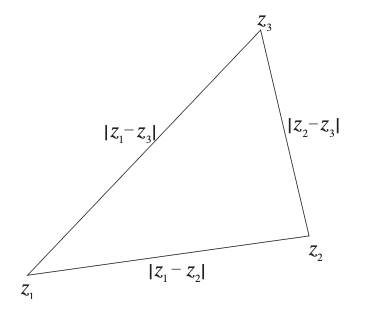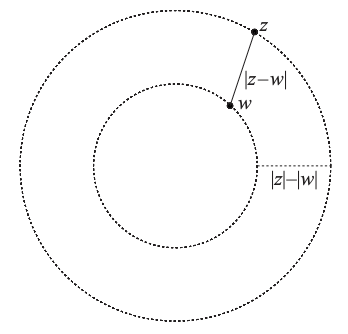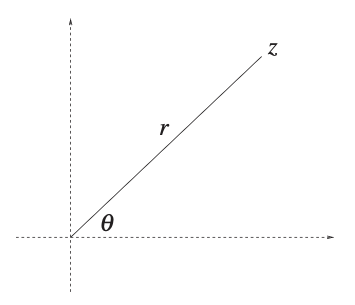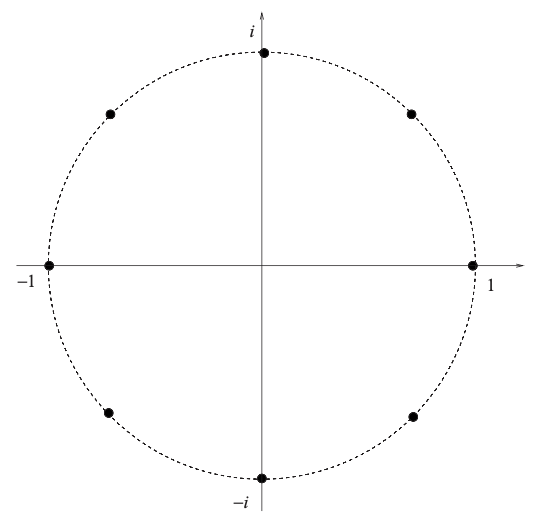Complex Numbers
Definition. A complex number is a number $z \in \mathbb{C}$ of the form $z = a + bi$ where $a, b \in \mathbb{R}$ and $i^2 = -1$. We called $a = \text{Re}(z)$ the real part and $b = \text{Im}(z)$ the imaginary part.
Theorem. The representation of a complex number $z$ in terms of its real and imaginary parts is unique.
Proof.
Let $a, b, c, d \in \mathbb{R}$ such that
\[\begin{align*} a + bi &= c + di \\ (a-c)^2 &= -(d-b)^2 \end{align*}\]As both $(a - c)^2 \ge 0$ and $(d - b)^2 \ge 0$, the equation is only possible with $a - c = 0$ and $b - d = 0$.
Hence, the representation is unique and if $z_1 = z_2$, then $\text{Re}(z_1) = \text{Re}(z_2)$ and $\text{Im}(z_1) = \text{Im}(z_2)$.
Definition. Let $z_1 = a + bi$ and $z_2 = c + di$, in order to follow the arithmetic rules for reals, together with the rule $i^2 = 1$, we have
Addition/Subtraction
\[z_1 \pm z_2 = (a + c) \pm (b + d)i\]Multiplication
\[z_1z_2 = (ac - bd) + (ad + bc)i\]Inverse
\[z^{-1} = {1 \over z} = {a \over a^2 + b^2} + {-b \over a^2 + b^2}i\]Division
\[z_1/z_2 = z_1z_2^{-1}\]
Complex Conjugate
Definition. The complex conjugate $z^\ast$ (or $\bar{z}$) of $z = a + bi$ is $z^{\ast} = a - bi$.
Proposition. $(z^\ast)^\ast = z$.
Proposition. $z = z^\ast$ iff $z \in \mathbb{R}$. $z = -z^\ast$ iff $z$ is pure imaginary.
Proposition. If $zw \in \mathbb{R}$, then $z = \lambda w^\ast$ for some $\lambda \in \mathbb{R}$.
Proof.
As $zw = (zw)^\ast$,
\[{z \over w^\ast} = {z^\ast \over w} = \left({z \over w^\ast}\right)^\ast\]Hence, $z / w^\ast = \lambda \in \mathbb{R}$ and $z = \lambda w^\ast$.
Proposition. Conjugation is distributive over addition, subtraction, multiplication and inverse, i.e.
$(z_1 \pm z_2)^\ast = z_1^\ast \pm z_2^\ast$
$(z_1z_2)^\ast = z_1^\ast z_2^\ast$
$(z^{-1})^\ast = (z^\ast)^{-1}$
Hence, we also have $(z^n)^\ast = (z^\ast)^n$.
The complex conjugate can be useful for converting complex fraction to a complex number:
\[{z_1 \over z_2} = \left({z_1 \over z_2}\right) \left({z_2^\ast \over z_2^\ast}\right) = {ac + bd \over c^2 + d^2} + {bc - ad \over c^2 + d^2}i\]Definition. Given a complex-valued function $f$, the complex conjugate function $f^\ast$ is defined by
\[f^\ast(z^\ast) = [f(z)]^\ast \implies f^\ast(z) = [f(z^\ast)]^\ast\]
For example, let $f(z) = pz^2 + qz + r$, we have
\[f^\ast(z^\ast) = (pz^2 + qz + r)^\ast = p^\ast(z^\ast)^2 + q^\ast z^\ast + r^\ast \implies f^\ast(z) = p^\ast z^2 + q^\ast z + r^\ast\]Modulus
Definition. The modulus $\vert z \vert$ of $z$ is defined by
\[|z| = \sqrt{a^2 + b^2}\]
Lemma. $\vert z^\ast \vert = \vert z \vert$.
Lemma. $zz^\ast = \vert z \vert^2$.
Lemma. $z^{-1} = z^\ast / \vert z \vert^2$.
Theorem. $\vert z_1z_2 \vert = \vert z_1 \vert \vert z_2 \vert$.
Proof.
\[\begin{align*} \vert (a + bi)(c + di) \vert^2 &= \vert (ac - bd) + (ad + bc)i \vert^2 \\ &= (ac - bd)^2 + (ad + bc)^2 \\ &= (ac)^2 + (bd)^2 - 2abcd + (ad)^2 + (bc)^2 + 2abcd \\ &= a^2(c^2 + d^2) + b^2(c^2 + d^2) \\ &= (a^2 + b^2) + (c^2 + d^2) \\ &= \vert a + bi \vert^2 \vert c + di \vert^2 \end{align*}\]
Argument
Definition. The argument $\arg(z)$ of $z$ is defined by
\[\arg(z) = \tan^{-1}\left({b \over a}\right)\]which has a period of $2\pi$.
Theorem. For any $z_1, z_2 \in \mathbb{C}$, with a period of $2\pi$,
$\arg(z_1z_2) = \arg(z_1) + \arg(z_2)$
$\arg(z^{-1}) = \arg(z^\ast) = - \arg(z)$
Proof.
Let $z_1 = a + bi$ and $z_2 = c + di$, we have
\[\begin{align*} \tan(\arg(z_1) + \arg(z_2)) &= {\tan \arg(z_1) + \tan \arg(z_2) \over 1 - \tan \arg(z_1) \tan \arg(z_2)} \\ &= {b/a + d/c \over 1 - bd / ac} \\ &= {ad + bc \over ac - bd} \\ &= \tan \arg(z_1z_2) \end{align*}\]Hence, $\arg(z_1z_2) = \arg(z_1) + \arg(z_2)$.
By definition, $\arg(z_1^\ast) = \arg(z_1^{-1}) = -b/a = - \arg(z_1)$ as $\tan^{-1} x = - \tan^{-1} x$.
Argand Diagram
Definition. An Argand diagram is a diagram in which a complex number $z = x + yi$ is represented by a vector $\mathbf{p} = \begin{pmatrix} x \\ y \end{pmatrix}$ on Cartesian plane. The $xy$ plane is referred as complex plane with real axis and imaginary axis.

The Argand diagram allows us to interpret complex numbers geometrically, i.e.
-
The modulus of $z$ corresponds to the magnitude of the vector.
-
The complex conjugate $z^\ast$ is the mirror image of $z$ reflected in the real axis.
-
Addition obeys the Parallelogram Law of Addition like vector addition.
Inequalities
By geometry, we observed the following inequalities about modulus:
Lemma. $\vert \text{Re}(z) \vert \le \vert z \vert$ and $\vert \text{Im}(z) \vert \le \vert z \vert$.
Theorem. [Triangle Inequality] If $z_1, z_2 \in \mathbb{C}$, then
\[\vert z_1 + z_2 \vert \le \vert z_1 \vert + \vert z_2 \vert\]Proof.
Self-evident by geometry or algebraically
\[\begin{align*} 1 &= \text{Re} \left( {z_1 + z_2 \over z_1 + z_2} \right) \\ &= \text{Re} \left( {z_1 \over z_1 + z_2} \right) + \text{Re} \left( {z_2 \over z_1 + z_2} \right) \\ &\le \left\vert {z_1 \over z_1 + z_2} \right\vert + \left\vert {z_2 \over z_1 + z_2} \right\vert \end{align*}\]
Corollary. $\vert z_1 + z_2 + … + z_n \vert \le \vert z_1 \vert + \vert z_2 \vert + … + \vert z_n \vert$.
Lemma. $\vert z_1 - z_2 \vert$ is the distance between the two points represented by $z_1, z_2 \in \mathbb{C}$.
Proof.
By Pythagoras’ theorem.

Corollary. $|z_1 - z_3| \le |z_1 - z_2| + |z_2 + z_3|$.
Proof.
Self-evident by geometry or by substituting $z_1’ = z_1 - z_2$ and $z_2’ = z_2 - z_3$ into the triangle inequality.

Corollary. $\vert z_1 - z_2 \vert \ge \vert \vert z_1 \vert - \vert z_2 \vert \vert$.
Proof.
Let $z_1 = z_1’ + z_2’$ and $z_2 = z_2’$, so $z_1’ = z_1 - z_2$ and $z_2’ = z_2$. Thus, we have
\[\vert z_1 \vert \le \vert z_1 - z_2 \vert + \vert z_2 \vert\]which implies
\[\vert z_1 - z_2 \vert \ge \vert z_1 \vert - \vert z_2 \vert\]Interchanging $z_1$ and $z_2$ we also have
\[\vert z_2 - z_1 \vert = \vert z_1 - z_2 \vert \ge \vert z_2 \vert - \vert z_1 \vert\]Hence, combining both cases, we have $\vert z_1 - z_2 \vert \ge \vert \vert z_1 \vert - \vert z_2 \vert \vert$.
Corollary. $\vert z_1 + z_2 \vert \ge \vert \vert z_1 \vert - \vert z_2 \vert \vert$, which gives a lower bound of $\vert z_1 + z_2 \vert$.
Proof.
\[\vert z_1 \vert = \vert (z_1 + z_2) - z_2 \vert \le \vert z_1 + z_2 \vert + \vert -z_2 \vert = \vert z_1 + z_2 \vert + \vert z_2 \vert\]which implies
\[\vert z_1 + z_2 \vert \ge \vert z_1 \vert - \vert z_2 \vert\]Interchanging $z_1$ and $z_2$ we also have
\[\vert z_2 + z_1 \vert = \vert z_1 + z_2 \vert \ge \vert z_2 \vert - \vert z_1 \vert\]Hence, combining both cases, we have $\vert z_1 + z_2 \vert \ge \vert \vert z_1 \vert - \vert z_2 \vert \vert$.
Polar Representation
The use of polar coordinates to represent position in Argand diagram is really helpful to understand some of the properties.

Definition. Let $x = r\cos\theta$ and $y = r\sin\theta$, the modolus/argument form of a complex number $z$ is
\[z = r(\cos\theta + i\sin\theta)\]where $r = \vert z \vert$ is the modulus and $\theta = \arg(z)$ is the argument.
The pair $(r, \theta)$ specifies $z$ uniquely, but $z$ does not specify $(r, \theta)$ uniquely since $\arg(z)$ has a period of $2\pi$. Hence, we need to define the principal value of $\theta$ such that $-\pi < \theta \le \pi$.
Theorem. The principal value of $\theta \in (-\pi, \pi]$ is given by
\[\theta = 2\tan^{-1} \left( {y \over x + |z|} \right)\]Proof.
$\tan^{-1}$ is single valued on the interval $(-{\pi \over 2}, {\pi \over 2})$. By the half-angle identity,
\[\tan {\theta \over 2} = {\sin \theta \over 1 + \cos \theta} = {y/r \over 1 + x/r} = {y \over x + r}\]Hence, when $\theta \in (-\pi, \pi]$,
\[\theta = 2\tan^{-1} \left( {y \over x + |z|} \right)\]
The modulus/argument form is helpful to understand the geometric meaning of multiplication.
Theorem. Multiplication of $z_1$ by $z_2$ scales $z_1$ by $\vert z_2 \vert$ and rotates $z_1$ by $\arg(z_2)$.
Proof.
Let $z_1 = r_1(\cos \theta_1 + i \sin \theta_1)$ and $z_2 = r_2(\cos \theta_2 + i \sin \theta_2)$, then
\[\begin{align*} z_1z_2 &= r_1r_2((\cos \theta_1 \cos \theta_2 - \sin \theta_1 \sin \theta_2) + i (\sin \theta_1 \cos \theta_2 + \sin \theta_2 \cos \theta_1)) \\ &= r_1r_2(\cos (\theta_1 + \theta_2) + i \sin (\theta_1 + \theta_2)) \end{align*}\]Hence, we have $\vert z_1z_2 \vert = \vert z_1 \vert \vert z_2 \vert$ and $\arg(z_1z_2) = \arg(z_1) + \arg(z_2)$ like we proved algebraically before.
Exponential Form
Consider the Taylor’s expansion of $\exp(x)$, $\sin(x)$ and $\cos(x)$, we have
\[e^{i\theta} = \cos \theta + i \sin \theta\]Theorem. For any $z \in \mathbb{C}$, we have
\[z = r(\cos\theta + i\sin\theta) = re^{i\theta}\]
The geometric meaning of multiplication can easily be derived from the exponential form:
\[z_1z_2 = (r_1e^{i\theta_1})(r_2e^{i\theta_2}) = r_1r_2e^{i(\theta_1 + \theta_2)}\]Corollary. $z^\ast = r(\cos\theta - i\sin\theta) = re^{-i\theta}$.
Corollary. For $w \in \mathbb{C}$,
\[\cos w = {1 \over 2} \left( e^{iw} + e^{-iw}\right) \quad\quad \sin w = {1 \over 2i} \left( e^{iw} - e^{-iw}\right)\]
Roots of Unity
Theorem. Let $n$ be a positive integer. The n-th roots of unity are the distinct complex numbers
\[1, \omega, \omega^2, ..., \omega^{n-1}\]where $\omega = e^{2\pi i/n}$, which are the $n$ distinct solutions of $z^n = 1$.
Proof.
Firstly, we have $\omega^n = e^{2\pi i} = 1$.
Let $k \in \set{0, 1, 2, …, n-1}$,
\[(\omega^k)^n = (\omega^n)^k = 1\]Therefore, $1, \omega, \omega^2, …, \omega^{n-1}$ are solutions of $z^n = 1$. They are obviously distinct because $\arg(\omega^k) = 2\pi k/n$.
Conversely, suppose $z = re^{i\theta}$ is a solution of $z^n = 1$, we have $z^n = r^ne^{in\theta} = 1$. Therefore, $r^n = 1$ and $n\theta = 2k\pi$ with $k \in \mathbb{Z}$. Hence, we have $r = 1$ and by limiting $0 \le \theta < 2\pi$, $\theta = 2k\pi/n$ with $k = 0, 1, 2, …, n-1$.
The result can be generalized to equation $z^n = w$ with $w \not= 0$. Let $w = re^{i\theta}$ and $z_0 = r^{1/n}e^{i\theta/n}$, then $z_0^n = w$. Therefore, $(z/z_0)^n = 1$. Hence, $z_0, z_0\omega, z_0\omega^2, …, z_0\omega^{n-1}$ are the $n$ distinct solutions.
Furthermore, following from the sum of geometric series and $\omega^n = 1$,
\[1 + \omega + \omega^2 + ... + \omega^{n-1} = {1 - \omega^n \over 1 - \omega} = 0\]Geometrically, the n-th roots of unity are the vertices of a regular n-gon on the complex plane, which are evenly spaced around a circle.

Logarithms and Powers
Definition. For $z \in \mathbb{C}$, $\log(z)$ is defined as “the” solution $w$ of $e^w = z$. Hence, by definition, we have
\[\exp(\log(z)) = z\]and given $w = \log(z)$,
\[\begin{align*} \log(\exp(w)) &= \log(\exp(\log(z))) \\ &= \log(z) \\ &= w \end{align*}\]
Theorem. $\log(z) = \log(|z|) + i\arg(z)$.
Proof.
Let $z = re^{i\theta}$ and $w = \log(z) = x + yi$. From the definition, we have
\[z = \exp(w) = e^{x + yi} = (e^x)(e^{iy}) = re^{i\theta}\]Hence,
\[\begin{align*} x &= \log(r) = \log(|z|) \\ y &= \theta + 2k\pi = \arg(z) \end{align*}\]which is multi-valued as $\arg(z)$ is multi-valued function.
Definition. The principal value of $\log(z)$ is $-\pi < \arg(z) = \text{Im}(\log(z)) \le \pi$.
Although $\log(-1)$ has no solution in real, under complex logarithms, we have
\[\log(-1) = \log(1) + i\pi\]Corollary. Similar to real logarithm, $\log(z_1z_2) = \log(z_1) + \log(z_2)$
Proof.
\[\begin{align*} \log(z_1z_2) &= \log(\vert z_1 \vert \vert z_2 \vert) + i \arg(z_1z_2) \\ &= \log(\vert z_1 \vert) + i\arg(z_1) + \log(\vert z_2 \vert) + i \arg(z_2) \\ &= \log(z_1) + \log(z_2) \end{align*}\]
Base on the definition of complex logarithm, we can now define the complex power of a complex number.
Definition. For $z \not = 0$ and $z, w \in \mathbb{C}$, $z$ to the complex power of $w$ is
\[z^w = e^{w \log z}\]Since $\log(z)$ is multi-valued, $z^w$ is only defined to an arbitrary multiple of $e^{2k\pi i w}$.
De Moivre’s Theorem
Theorem. [De Moivre’s Theorem] For $\theta \in \mathbb{R}$ and $n \in \mathbb{Z}$,
\[\cos n\theta + i\sin n\theta = (\cos \theta + i\sin \theta)^n\]Proof.
As $\cos \theta + i\sin \theta = e^{i\theta}$, we have
\[\begin{align*} \cos n\theta + i \sin n\theta &= e^{i(n\theta)} \\ &= (e^{i\theta})^n \\ &= (\cos \theta + i \sin \theta)^n \end{align*}\]
The theorem can be extended to $\theta, n \in \mathbb{C}$ with $\cos n \theta + i \sin n \theta$ equals to one of the values of $(\cos \theta + i\sin \theta)^n$.
Complex Plane Geometry
Lines
Theorem. For $z_0, w \in \mathbb{C}$ with $w \not = 0$ and varying $\lambda \in \mathbb{R}$, the equation
\[z = z_0 + \lambda w\]represents points on a straight line passing through $z_0$ and parallel to $w$, which is similar to point-slope form.
Corollary. An alternative representation of a line passing through $z_0$ and parallel to $w$ in complex plane is
\[zw^\ast -z^\ast w = z_0w^\ast - z_0^\ast w\]Proof.
As $\lambda \in \mathbb{R}$, $\lambda = \lambda^\ast$, we have
\[{z - z_0 \over w} = {z^\ast - z_0^\ast \over w^\ast}\]The equation can be derived from reordering of the terms.
Hence,
Theorem. The general representation of a line is
\[a^\ast z + az^\ast + b = 0\]Let $u, v \in \mathbb{C}$ be two points, then
\[a = v -u \quad \text{and} \quad b = \|u\|^2 + \|v\|^2 \in \mathbb{R}\]Proof.
Given $u, v \in \mathbb{C}$, the points that are equidistant from them, i.e.
\[|z - u|^2 = |z - v|^2\]form a straight line.
As $|z - u|^2 = (z - u)(z^\ast - u^\ast)$ and $|z - v|^2 = (z - v)(z^\ast - v^\ast)$, we have
\[(v^\ast - u^\ast)z + (v - u)z^\ast + |u|^2 + |v|^2 = 0\]
Practically, it will be more useful to represent the straight line passing through two points $u$ and $v$ as parametric form
\[z - u = \lambda(v - u) \quad \text{or} \quad z = (1 - \lambda)u + \lambda v\]Details about different forms can be found here and here.
Circles
Theorem. The points on a circle in the complex plane with centre $w$ and radius $r$ is given by the equation
\[|z - w| = r\]Since $r^2 = |z - w|^2 = (z - w)(z^\ast - w^\ast)$, the general form of a circle is
\[zz^\ast - (zw^\ast + z^\ast w) + |w|^2 = r^2\]
References
- Stephen J. Cowley Algebra and Geometry Lectures Notes, 2006 - Chapter 1
- Alan F. Beardon Algebra and Geometry, 2005 - Chapter 3
- https://www.landonlehman.com/post/lines-in-the-complex-plane/
- https://proofwiki.org/wiki/Equation_for_Line_through_Two_Points_in_Complex_Plane